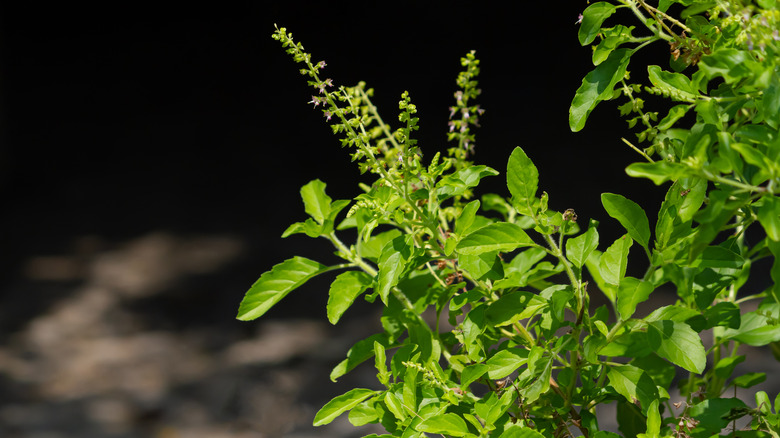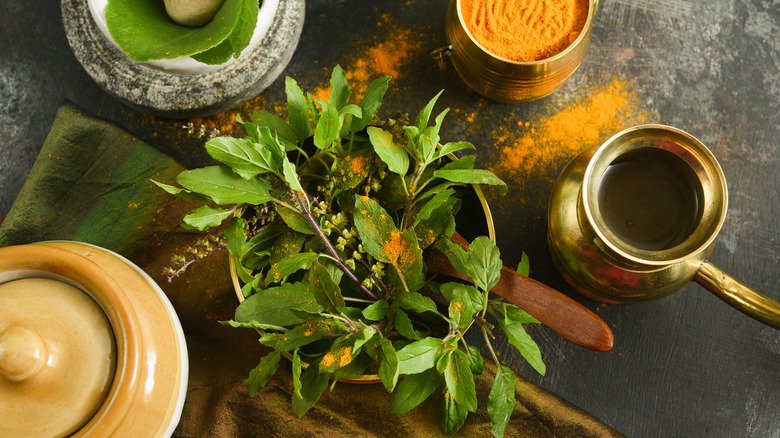Why Some Hindu Homes Have Four Deities Surrounding The Tulsi Plant
If you have spent time in India or have Hindu friends you may have noticed the tulsi plant lurking in homes and courtyards (via Learn Religions). Tulsi, tulasi, or holy basil is a sacred plant, venerated in Hinduism due to its medicinal properties and for its appearance in a range of religious stories.
Tulsi can be found all over Southern Asia (via Indian Culture) and in India the plant shows up in a very wide array of religious rituals and traditions. Tulsi stems are sometimes used to make necklaces, and tulsi leaves are offered to Vishnu during the month of Karttika (via Krishna). At Holi, the spring festival (which you may be familiar with due to its stunning paint-throwing celebrations), tulsi is one of the plants used to make colorful dyes (via Yale University).
Most importantly, tulsi is commonly kept at home, often in a special area in the courtyard, flanked by four hindu deities. This is partly in order to venerate the god Vishnu (it is, after all, his favorite plant), but also because tulsi itself is a goddess (via The Divine India).
A legendary herb
Tulsi is associated with several different Hindu deities for various reasons. As a Goddess, Tulsi was married to Lord Vishnu, and this marriage is symbolically celebrated each year just before the wedding season, during Tulsi Vivah (via The Times of India).
Tulsi is mentioned in a whole host of Hindu texts, including the Bhagavad Gita, one of the foundational texts of Hinduism, written several thousand years ago (via World History).
In the Gita, the use of tulsi to worship Vishnu was firmly established. It reads: "Kṛṣṇa [Vishnu's avatar] desires that one offer Him either a leaf, or a flower, or fruit, or a little water—and by such an offering He is satisfied. This leaf especially refers to the tulasī. So one can sow tulasī and pour water on the plant. Thus, even the poorest man can engage in the service of Kṛṣṇa" (via Vani Quotes).
Stories about the plant goddess vary. In Hindu mythology, Tulsi is sometimes said to have been a human woman, a princess who fell in love with Krishna under tragic circumstances (via Learn Religions). In other stories, the plant is associated with the goddess Lakshmi — the wife of Vishnu and therefore an appropriate gift for the god (via Sanskrit Magazine).
More precious than gold
According to one notable tulsi legend, the god Vishnu was once weighed in gold. Although the gold produced from this weighing was vast, when placed on the other side of the scale, a single tulsi leaf was said to match him (via Learn Religions). This story is quite fitting, for although Tulsi is a common herb, it is extremely valuable for its many uses and health benefits.
Tulsi is used in Ayurvedic medicine — an Indian medicinal system with ancient roots (via U.S. Department of Health and Human Services) — and it is still used to cure everything from the common cold to malaria. Some of the ancient claims about the health benefits of tulsi have also been confirmed by modern science, with researchers reporting that tulsi can lower glucose levels and may benefit those suffering from stress and high blood pressure (via The National Library of Medicine).
The darker version of the plant, which is colored black or purple (Krishna tulsi) is slightly more potent, and it is traditionally preferred for making medicines. Those interested in reaping some of tulsi's benefits should chew the leaf or drink it as tea, as is traditionally done in India (via Indian Culture).


